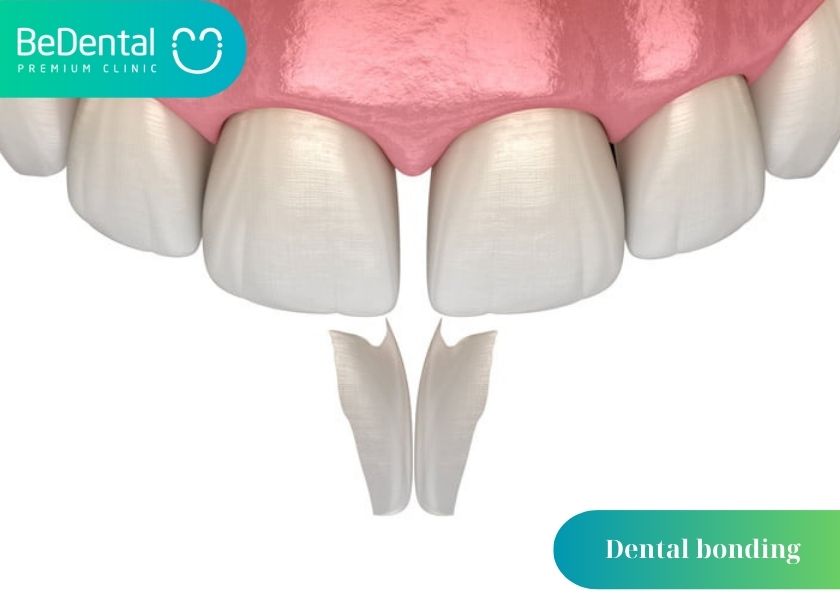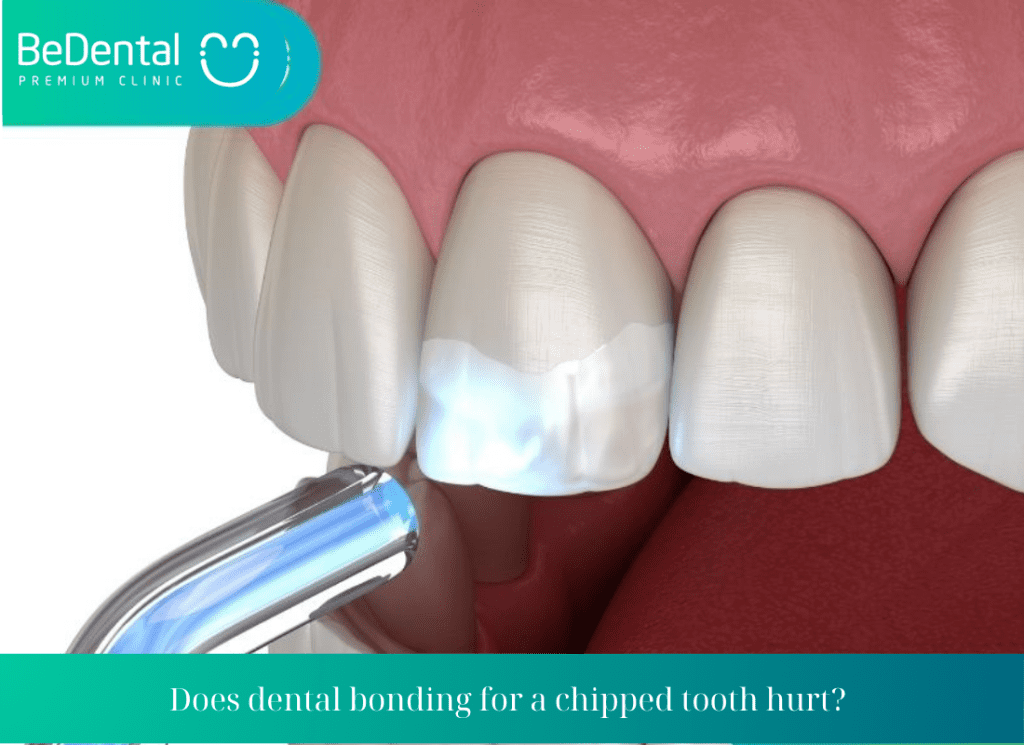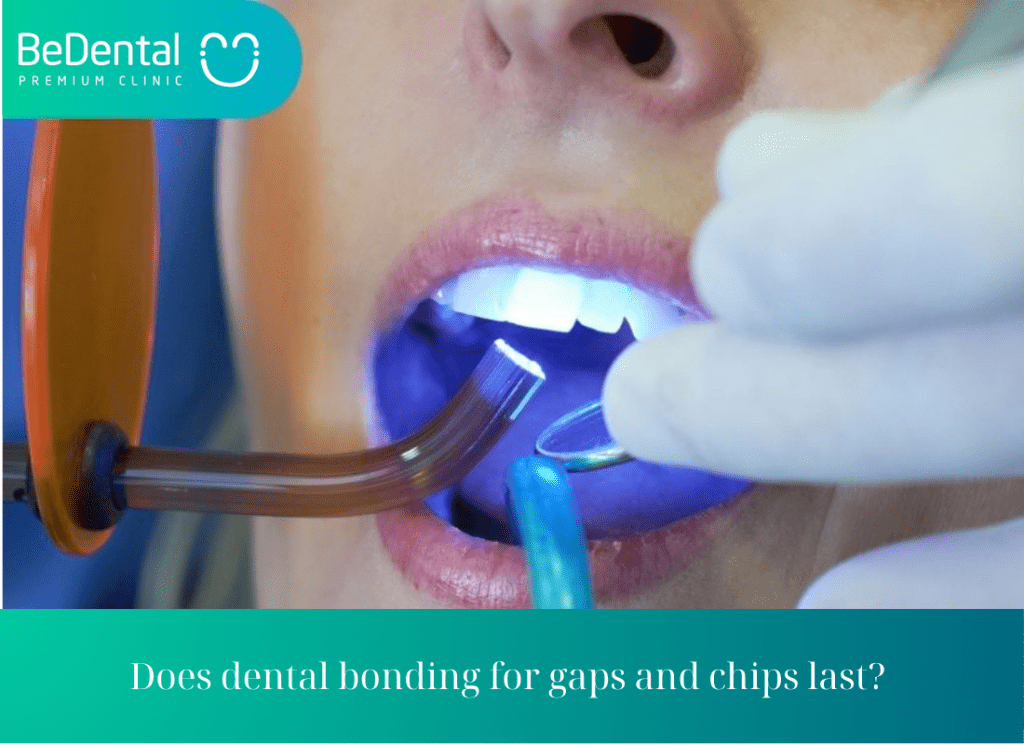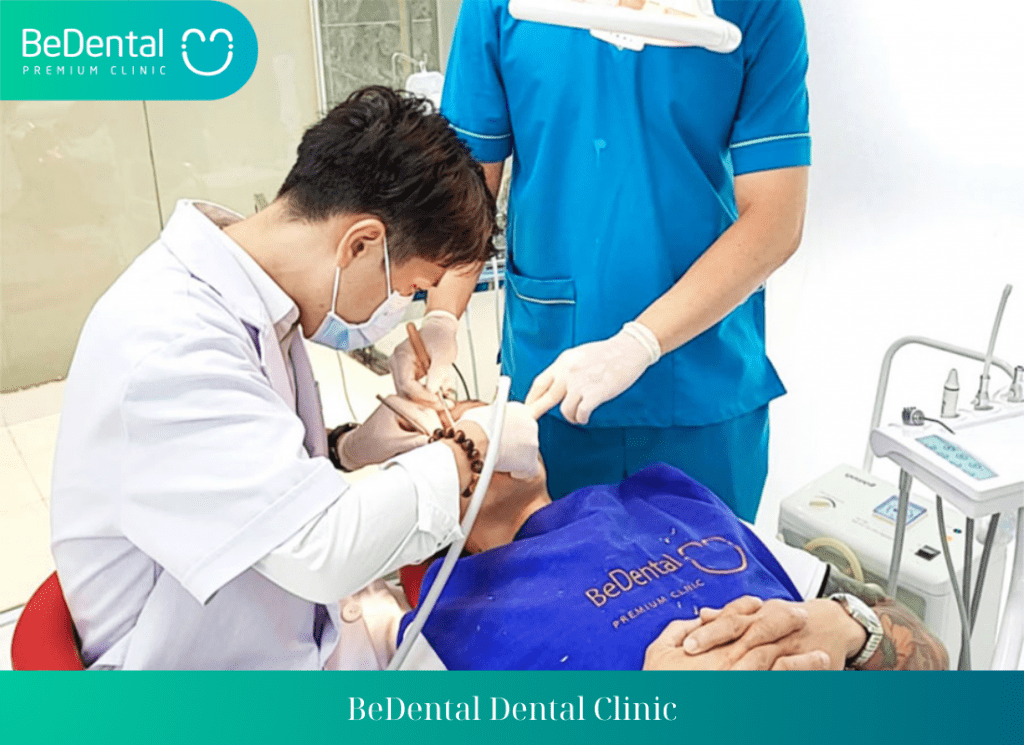Are you experiencing issues with gaps or chipped teeth? How much does dental bonding cost for them? Are you seeking a cost-effective solution to enhance the appearance of your teeth?
This article will provide answers to all your questions regarding dental bonding – an effective and budget-friendly treatment option. You will learn about the cases that require dental bonding for gaps, whether it can be used for chipped teeth, the dental bonding cost, and the durability of the bonding process. Let BeDental guide you through this article to find the most detailed answers to your inquiries.
Can gaps be fixed with dental bonding?
Dental bonding is an innovative and effective solution for addressing gaps, helping to restore a natural and beautiful smile. This method is not only simple and safe but also cost-effective compared to traditional approaches. When considering affordability, many patients ask about the dental bonding cost.
However, to ensure the best results, the application of dental bonding needs to be carefully assessed and evaluated to suit each individual case.
According to dental experts, dental bonding is recommended for cases with small gaps between teeth. When the gap is too wide, the bonding material may not adhere properly, resulting in significantly reduced durability. Understanding the dental bonding cost is important, but so is knowing if the procedure is right for you.
If you intentionally choose to have dental bonding for a wide gap, you may initially feel comfortable, but later on, you may encounter difficulties as the bonding material becomes loose or chips when biting into hard objects. Therefore, it is important to be cautious and thoroughly research before deciding on dental bonding for gaps to ensure the best results for your oral health, and to understand the dental bonding cost implications

Can dental bonding be done for diastema (gap between front teeth)?
For cases of diastema or gaps between front teeth, dental bonding can still be performed. Instead of spending a significant amount on dental veneers or braces, dental bonding remains a viable option. It is known that undergoing dental bonding for diastema offers numerous benefits, including:
- Preserving the natural teeth.
- Ensuring proper chewing function.
- Potentially addressing any existing tooth decay.
- Providing aesthetic improvements, as the front teeth are considered the focal point of the smile.
When considering this option, be sure to ask about the dental bonding cost.
See more: Choosing between dental fillings for tooth erosion or dental crowns
The two best materials used for dental bonding for gaps
There are many materials used for dental bonding. However, if you need to address the issue of gaps, especially in the molar or premolar areas, composite bonding and inlay-onlay are the best options available. Specifically:
Closing gaps with composite bonding material

Composite is a commonly used material for dental bonding for gaps. Compared to other bonding materials on the market, composite has many outstanding advantages. In terms of quality, dental bonding cost, and aesthetics, composite is highly regarded.
Advantages of using composite bonding for gaps
- Ensures comprehensive aesthetics as composite closely resembles natural teeth. The color, shade, and translucency are all very similar to the original teeth. Whether bonding is done in the molar or premolar area, it achieves high aesthetic results.
- Composite bonding provides good resistance to forces.
- The bonding process is quick, usually completed in about 1 day.
- Repairs are simple if needed.
- Does not cause invasive damage to the natural tooth enamel.
- Assessing the dental bonding cost with composite is a smart move.
Disadvantages of using composite bonding for gaps
- Composite bonding can change color or become stained from food or drinks. When it changes color, it can significantly affect aesthetics.
- Composite bonding for gaps is only recommended for small spaces. If the gap is larger than 2mm, the bonding material can quickly become loose, chip, or break. Before choosing, consider the dental bonding cost and its longevity.
If composite bonding is not considered durable due to discoloration after a few years, you can consider using inlay-onlay material. Inlay-onlay is a ceramic material and is always the best choice for all cases of bonding for gaps or repairing chipped teeth.
Advantages of using inlay-onlay bonding for gaps
- The material closely resembles ceramic tooth enamel, providing extremely high aesthetics. It is slightly better than composite in terms of aesthetics.
- Inlay-onlay bonding has excellent hardness and durability. It is known that inlay-onlay ceramic is 5 times harder than natural teeth. Therefore, many customers choose this ceramic coating method to protect their teeth.
- Inlay-onlay is not affected by temperature or external environment, so it does not change or warp. Therefore, when bonding for chipped teeth or repairing cracked teeth, it does not create future gaps.
- Inlay-onlay bonding uses a similar technique to ceramic veneers but does not require tooth grinding. Therefore, it minimizes unnecessary invasion of soft tissues in the mouth and maximizes the protection of natural tooth structure. The dental bonding cost for inlay-onlay is often higher, but the durability makes it worthwhile.

Disadvantages of using inlay-onlay bonding for gaps:
Although inlay-onlay ceramic material is considered optimal for bonding, the dental bonding cost is a significant obstacle. Investing in this material can be a difficult decision for those with limited budgets.
Can a chipped tooth be bonded? When should it be done?
Can a chipped tooth be bonded? A chipped tooth is a common issue in daily life. This can happen when you accidentally bite on something too hard or experience trauma. A chipped tooth not only affects aesthetics but also makes chewing food difficult and causes discomfort. It is important to know the dental bonding cost before choosing this treatment.
Therefore, dental bonding can be a great solution to address this issue. By bonding the tooth, you not only restore its aesthetics but also make the chewing process easier and more comfortable. Cases in which tooth bonding can be done for a chipped tooth include:
- A chipped front tooth due to minor trauma that causes the tooth to crack or break, but not severely. This means only a small portion of the tooth is lost, while the tooth root and structure remain healthy.
- Teeth with cavities or enamel erosion can undergo bonding.
- When the junction between the tooth and gum tissue is eroded, known as cervical erosion.
See more: Can teeth whitening be done after dental filling

Note: When performing dental bonding for a chipped tooth, careful consideration should be given to the extent of the tooth damage. If the tooth structure is thin and the chip is large, bonding may not be the optimal solution. In such cases, the bonded area may easily chip or the filling may come off. It’s best to discuss the dental bonding cost and suitability with your dentist.
Does dental bonding for a chipped tooth hurt?
Many people are concerned about whether dental bonding for a chipped tooth is painful, as the area around the tooth is quite sensitive and can cause discomfort. However, there is no need to worry too much about this issue. The techniques for bonding a chipped tooth nowadays are simple and effective. Before starting the procedure, the dentist will use anesthesia to minimize any pain sensation.
Furthermore, choosing an experienced dentist along with modern equipment and technology will ensure that the bonding process is quick and accurate. Therefore, you can have complete peace of mind when getting a chipped tooth bonded, without having to worry about any painful experiences. Also, ask about the dental bonding cost to avoid surprises

How long does dental bonding take? How many minutes does it take?
Determining the duration of dental bonding for gaps or chipped teeth will help you plan and manage your schedule effectively. Typically, the bonding process can be completed in just one day. The duration will vary depending on the specific condition of your teeth, ranging from 15 to 45 minutes. Specifically:
- For mild tooth damage: This is when the tooth is only slightly chipped or cracked, without affecting the pulp. The bonding process will take about 15 to 20 minutes.
- For moderate tooth damage: This is when the dentist needs to remove the damaged tooth structure before placing the filling. The duration will range from 30 to 40 minutes.
- For severe tooth damage: This is a case where the tooth has been significantly affected, including the pulp. In such cases, the dentist will need to perform root canal treatment first. After the tooth is stabilized, the bonding can be done to restore the damaged area. When planning, also consider the dental bonding cost as part of your budget.
Does dental bonding for gaps and chips last? How many years is the maximum?
When it comes to bonding for gaps or chips in teeth, the durability and longevity are among the top concerns. Nobody wants the bonded area to chip or break off, requiring another trip to the dentist for re-bonding. This not only incurs additional costs but also takes up more time.
In practice, the durability of dental bonding can vary. In terms of materials, if composite resin is used for bonding, the durability can range from 2 to 3 years. If amalgam is used, the durability can range from 10 to 15 years. And if porcelain is used, the durability is very high, lasting up to 15 to 20 years.

The effectiveness of bonding for gaps and chips depends on what factors?
Even if you choose high-quality bonding materials with excellent durability, poor care can still affect the longevity and appearance of the bonded area. Therefore, it is important to understand the factors that can impact the effectiveness of bonding and take appropriate care.
Here are three factors that determine the durability and appearance of dental bonding:
Bonding materials
The choice of bonding material is one of the key factors in determining the durability of bonding for gaps or chips. Each bonding material has its own advantages and disadvantages. You can consult with your dentist to select the most suitable bonding material for your specific case.
Bonding technique
The technique used by the dentist in bonding for gaps and chips also plays a crucial role in the durability and appearance of the bonded area. A skilled dentist with solid knowledge and expertise will ensure a gentle, comfortable, and durable bonding process.
On the other hand, if the dentist lacks experience, there may be errors in the procedure. Being too gentle may result in poor aesthetic outcomes and insufficient durability, while being too aggressive may lead to complications in the future.
Hygiene and post-bonding care
To maintain the durability and appearance of the bonded area, the final factor is proper oral hygiene and dietary habits. To ensure long-lasting bonding, you need to follow a scientific diet and practice proper oral hygiene.
Using a saline mouthwash daily can help eliminate bacteria in the mouth. Additionally, using dental floss to clean between teeth can prevent the formation of gaps. However, be cautious not to brush too vigorously, as this can cause the bonded area to chip or break off.
Furthermore, dietary habits are also important. Avoid consuming excessively hard foods that may impact the bonded area. By adhering to these factors, your bonded area will remain durable and beautiful, giving you peace of mind about your oral health.

How much does filling a gap in teeth cost? How much does dental bonding cost for gaps or chipped teeth?
The process of filling a gap in teeth is relatively simple. Therefore, the cost of filling a gap is not excessively expensive. The price range for filling a chipped or spaced tooth typically ranges from 200,000 to 500,000 VND. Depending on the location, condition of the tooth, and the number of teeth that need to be filled, the price may vary significantly.
In addition, the cost of filling a chipped tooth also depends on the severity of the dental condition. If you have tooth decay or pulpitis, the dentist may require treatment before proceeding with the filling. In this case, the overall cost of the filling may be slightly higher. Therefore, the answer to the question “How much does filling a gap in teeth cost?” will depend on each individual.
You can refer to the price list at BeDental for more information.
| Danh mục | Unit | Giá thành | |
|---|---|---|---|
| 1.Teeth filling (More detail...) | |||
| Baby teeth filling | 1 Unit | 250.000 ~ 10$ |
|
| Permanent Teeth Filling | 1 Unit | 500.000 ~ 20$ |
|
Cosmetic Filling | 1 Unit | 700.000 ~ 28$ |
|
Sensitive teeth filling | 1 Unit | 500.000 ~ 20$ |
|
| Composite bonding | 1 Unit | 1.000.000 ~ 40$ |
|
| 2.Root Canal Treatment - Anterior by endodontist machine (More detail...) | |||
| Root Canal Treatment - Anterior for baby teeth | 1 Unit | 800.000 ~ 31$ |
|
| Root Canal Treatment - Anterior for Front teeth | 1 Unit | 1.200.000 ~ 47$ |
|
| Root Canal Treatment - Anterior for Premolar teeth | 1 Unit | 1.500.000 ~ 59$ |
|
| Root Canal Treatment - Anterior for molar teeth | 1 Unit | 2.000.000 ~ 79$ |
|
| 3.Root Canal reTreatment - Anterior by endodontist machine | |||
| Root Canal Treatment - Anterior for Front teeth by endodontist machine | 1 Unit | 1.500.000 ~ 59$ |
|
| Anterior for Premolar teeth by endodontist machine | 1 Unit | 1.800.000 ~ 71$ |
|
| Anterior for molar teeth by endodontist machine | 1 Unit | 2.300.000 ~ 90$ |
|
| 4 Vecniflour dental care (More detail...) | |||
| Vecniflour dental care for child | 1 Unit | 500.000 ~ 20$ |
BeDental – The most reputable address for filling chipped teeth
You can easily find many dental clinics that offer filling for gaps and chips. However, to ensure both safety and durability of the filling, you should carefully choose and only visit reputable dental clinics like BeDental.
With a team of skilled dentists with years of experience in treatment, BeDental guarantees to provide effective treatment plans that are cost-effective for filling chipped teeth.
Moreover, with the support of modern equipment, the filling process will be gentle, quick, and free from any mistakes or complications. BeDental is also dedicated to caring for customers before and after the filling procedure.
Performing dental filling for gaps and chips is a quick, safe, and cost-effective cosmetic dental method compared to other methods. To get a specific quote or receive free consultation, you can contact BeDental for assistance.

Conclusion
In conclusion, finding a reputable address for filling chipped teeth is of utmost importance. Not only does it ensure the safety and effectiveness of the procedure, but it also provides peace of mind knowing that you are in the hands of skilled professionals.
BeDental is the epitome of a reputable address for filling chipped teeth, offering a range of high-quality services at affordable prices. With their experienced team of dentists and state-of-the-art equipment, BeDental guarantees exceptional results and a comfortable experience. Don’t settle for anything less when it comes to your oral health – choose BeDental as your trusted and reputable address for filling chipped teeth.
Tư vấn chuyên môn bài viết:
BÁC SĨ DƯƠNG THỊ THÙY NGA
Bác sĩ chỉnh nha tổng hợp
Ngôn ngữ giao tiếp: Tiếng Việt, Tiếng Anh, Tiếng Nga
Đặt Lịch Hẹn
Xem Hồ Sơ
Tư vấn chuyên môn bài viết:
BÁC SĨ DƯƠNG THỊ THÙY NGA
BEDENTAL - TOP STANDARD DENTISTRY SYSTEM
In HANOI
Address 1: 7B Thi Sach St, Ngo Thi Nham, Hai Ba Trung Dist, Ha Noi. - 0934.61.9090
Address 2: No 129 Hoang Ngan, Yen Hoa, Cau Giay Dist, Ha Noi. - 0934.61.9090
In HO CHI MINH
Address 1: 53 -55 -57 Pho Duc Chinh St, Nguyen Thai Binh, Dist. 1, Ho Chi Minh. - 0766.00.8080
Working: 9am - 8pm everyday
Website: https://bedental.vn/en/





